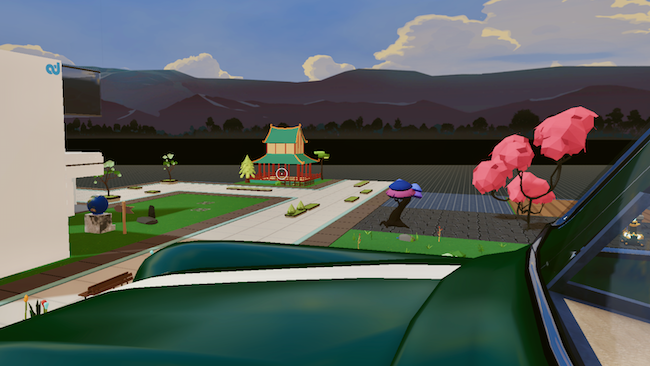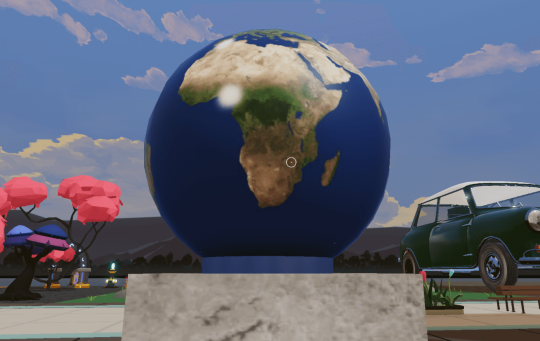After exploring some metaverse sites (Meta's Horizon World, VRChat, Decentraland, The Sandbox), you decide to launch your the Gumball Machine into that overhyped universe.
To compound the hype, you program the machine to dispense NFTs.
The Gumball Machine, now the Metaverse Gumball Machine, looks like this in Decentraland, in the metaverse.

District Hall Gumball Machine design, ported to the metaverse, wrapped with two planetary textures from Solar Systems Scope: "Earth: Daytime," and "Moon".
Here's the view from the hood of the Mini Cooper Museum next door.

The Metaverse Gumball Machine is way over on the bottom left, just over the giant right headlight of the Mini Cooper Museum.
So how do you distribute that NFT?
Easy. When an avatar approaches the Metaverse Gumball Machine, it triggers an interaction: submit a wallet address, get an NFT. Nothing else required. Within a few hours, the NFT will be in the wallet, easily verifiable on the blockchain.
It doesn't require much of a description:
This is a space shot into the emerging galaxy (or fake chimera, or group delusion) known as the metaverse. It blasted off from its perch in the Lounge in District Hall Boston.
More, for the interested:
The Gumball Machine, created at nearby Cambridge Hackspace, has been a fixture at District Hall since 2018. It leverages Internet-of-Things (IoT) technologies, embedded software, gesture sensors, blinky LED lights, laser cut designs, and 3D-printed sprockets to deliver surprises in 1-inch-diameter capsules.
After a few solid years of capsule dispensing, the Gumball Machine crew decided to launch into the metaverse, just for fun and to test out how NFTs and the metaverse work.
That's how, through the generosity of a German software engineer (at a non-profit agency for energy + climate change) with a little extra land on his hands, this Metaverse location became available as a metaverse landing pad for the Gumball Machine.
Way more, for the crypto nerds:
One easy way to launch a free NFT is via the Polygon blockchain. Polygon works on top of Ethereum which has become slow, and expensive to use.
But here's the thing: Polygon syncs up perfectly with Ethereum, which is still the #1 NFT platform.
All that NFT bubble-ly behavior that has been so annoying to witness (Bored Ape, Crypto Punks, etc.) -- it has funded terrific development of Ethereum, which is the "settlement layer" of Polygon. So Polygon is now a good choice for NFTs: virtually no gas fees, but ultimately "settled" on Top Choice, A-List Ethereum.
Polygon is a good choice for NFTs: virtually no gas fees, but ultimately "settled" on Top Choice, A-List Ethereum.
So, bottom line: even though many old-school NFT types might wince (because they are locked into Ethereum as their only option), Polygon delivers a better experience than Ethereum: faster and cheaper (tiny, tiny gas fees). The gas fees, really, are whispery, almost imperceptible (like 0.001).
The gas fees are whispery, almost imperceptible (like 0.001 MATIC, currently less than a penny USD). That's why we can offer this NFT for free.
And best of all: the Polygon network was built to provide a better experience for projects that operate in harmony with the Ethereum chain.
Polygon's Ethereum Virtual Machine (EVM) compatibility makes it ideal for developers looking to build efficient and secure projects. The Polygon network is Ethereum-native, aligned to be interoperable with all of Ethereum’s existing, and future, infrastructures.
That's important, because developers have been sharpening their skills on Ethereum, funded by early, crazy, well-funded NFT projects. All along they've been making Ethereum more solid, more bulletproof.
Polygon taps into that, without saddling buyers and sellers with layer-one mega gas fees.
